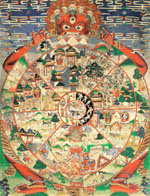
School: Pioneer Valley Performing Arts Charter Public School
Project Title: Karma and Vipaka
|
|
The Wheel of Life Art Project The Wheel of Life is a detailed illustration of the Tibetan belief in the transmigratory nature of existence. Human beings are born into this life with karma from a past life (or lives) and leave the world with vipaka, or the results of our actions. In Part I of this activity, students will learn how the Wheel of Life illustrates the beliefs of karma and in Part II, students will translate these images into their own contemporary interpretations. Materials
Part I Basics about the Wheel of Life Objective Identify the the three main parts of the Wheel, its symbols and how it teach us about the properties of Karma. Procedure 1. If possible, find a poster of the Wheel of Life or project an image of it from the internet (see link at the top of this page). Ask students-What is your first impression of this painting? What kind of feeling to you get (if any) when you look at this image? 2. Join students in to groups of 3 or 4. Distribute copies of the blank wheel of life to each student and steer them towards one of the internet links listed in the list of materials. Both sites, Buddhanet and the Rubin Museum offer a visual illustation of the Wheel wheel lots of fun interactive tools. Along with descriptions of the various symbols, you can also retrieve useful geographical maps, and historical information of the Buddha. 3. Have students label the following parts of the Wheel:
2. On a separate sheet of paper and using Buddhanet and the Explore Art once again, research these parts of the wheel of life. For each area of the Wheel, instruct students to answer the following questions: What does the monster of impermanence represent? Why is he (it) included in existence of mankind? What to each of the six realms represent? Buddhist belief states that there is suffering in all stages of birth an rebirth. What kind of suffering is exhibited in each of the realms? Why is Buddha included in each one of the realms? What purpose is he serving the inhabiters of each realm? Part II Building a Contemporary Wheel of Life Objective To use some of the images found in the original wheel of life and find contemporary images in print media. Through the use of artistic expression, students will create their own Wheel of Life, while leaving the significance of reach realm unchanged. This art project help internalize the ideas represented in the Wheel, and can be a great lead in to future discussion about the artwork, the Buddha's life, comparitive lessons in the artwork from other religions. Procedure 1. Place students into groups of four or five. 2. Supply them with: ~a large sheet of paper 3. On the large sheets of paper, instruct students to draw an outline of the wheel of life. After they finish, review with them the parts of the wheel identified in Part I and the significance of the illustration in the Buddha's teachings about karma. 4. Using magazines and newspapers, have students search for modern images of suffering identified throughout the Wheel of Life. For example, in the inner circle, we find the roots of all evil symbolized by three animals: a pig, a rooster, and a snake. Each represent one evil- the pig=ignorance, the rooster=lust, and the snake= hatred. Tell students to replace the symbols of these three evils with other items seen in magazines or newspapers. 5. Glue the images on to the wheel in the appropriate area in a collage-like format. Assessment Students will close the activity with a presentation of their Wheel of Life to the class. In the presentation, ask each student to explain at least one section of the wheel in its new, contemporary form. This way, everyone with have a chance to improve their skills and comfortablility in public speaking, while the more gifted students can take on more than one realm to explain, if needed.
Background information on the Wheel of Life The Wheel of Life is a detailed illustration of the Tibetan belief in the transmigratory nature of existence, explains the theory of rebirth. Human beings are born into this life with karma, the cycle of birth and rebirth, and the manifestations of suffering and desire experienced by human beings. In this activity, students will learn about the symbolism used in the painting to teach buddhist philosophy and then translate these images into own comtemporary interpretations. I. The Wheel is divided into three parts II. Axle A. In is one of the noble truths that suffering exists III. Spoke A. The universe in separated in to 6 realms B. Meritous or unmeritous actions dictate the realm in which rebirth happens-wholesome karma~rebirth into the human, god or demi-god realm C. No matter, human beings can’t escape suffering b/c suffering exists in each realm D. Buddha is ever present and he is seen in every realm, trying to help people toward enlightenment, showing compassion IV. Realm of the gods A. Enjoy life, lead a blissful life V. Realm of the Demi-Gods A. Leading trait: pride, jealousy, envy VI. Realm of the human beings A. Most important realm because humans have the opportunity to reach enlightenment VI. Realm of the animals A. Trait: inability to express themselves VII. Realm of the tantalized ghosts
|
|||||||||||
This site was created by Tricia Lea at the NEH Summer Institute "Cultures and Religions of the Himalayan Region," held at the College of the Holy Cross, Summer 2006
